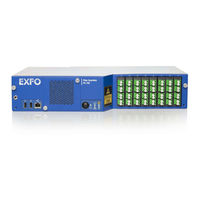
EXFO Fiber Guardian FG-750 Manuals
Manuals and User Guides for EXFO Fiber Guardian FG-750. We have 2 EXFO Fiber Guardian FG-750 manuals available for free PDF download: User Manual, Getting Started
EXFO Fiber Guardian FG-750 User Manual (359 pages)
Brand: EXFO
|
Category: Test Equipment
|
Size: 11 MB
Table of Contents
Advertisement
EXFO Fiber Guardian FG-750 Getting Started (16 pages)
Brand: EXFO
|
Category: Test Equipment
|
Size: 3 MB
Table of Contents
Advertisement

